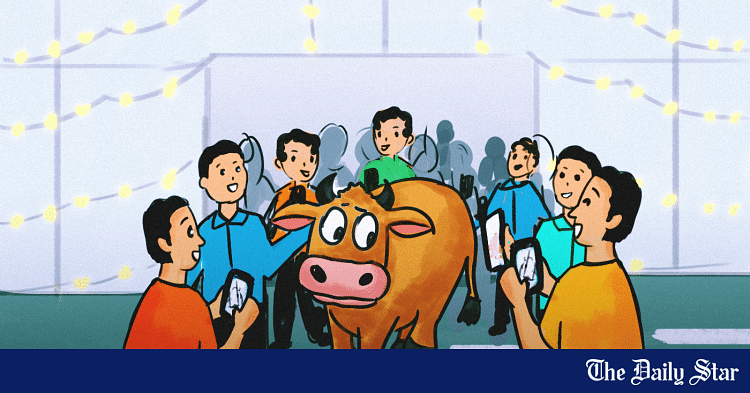Shopping
Cow running amok in a shopping mall: It’s not a ‘moo’ point

Every year, Eid-ul-Azha brings with it viral pictures or videos of human-cattle interactions that amuse some and bemuse others, but overall help to build anticipation for the more solemn occasion of cattle sacrifice. This year is no different. A video clip currently trending online features a runaway cow that—let’s say for now—decided to go shopping. The clip begins with what appears to be an overturned auto-rickshaw in front of a shopping mall in Dhaka. The cow, visibly agitated, with its handlers trying to hold onto its reins, leaves them behind to chase a few onlookers before making a dash for the mall entrance. It gallops up the stairs. Once in, it runs past a row of shops, slips into one in the far corner, and briefly hides there, much to the bewilderment of the crowd.
I must admit that I, like most people commenting on the video, was amused initially. After all, the short video is full of chaotic potential, with a side dish of humour served with a fitting music. Although sacrificial cows breaking loose on their way from haats or lunging at perceived attackers is not an uncommon sight, it still prompts an amused reaction during every Eid-ul-Azha. Netizens, as always, had some funny ideas about why the runaway cow behaved the way it did in front of a shopping mall. Stuff of another Gabhi Brittanto, one quipped.
Interestingly, the gabhi (cow) in question seemed to calm down a bit toward the end, inside the shop, where it found a caring pair of hands stroking its head. Its earlier behaviour can be attributed to fear or irritation. The way sacrificial cattle are often hauled off to their eventual destinations, hemmed in by all sorts of people and vehicles, each louder than the other, can be overwhelming for the shackled animals. The poor cow probably had a similar experience, and its instinctive response was to try to flee to a safer location, away from the chaos, confusion, and beatings.
But there are bigger things at work here. While we share and laugh at these viral videos of “cute chaos” caused by cows on our streets, they also bring to light a stark reality: the fast-vanishing space for animals in Bangladesh as people continue to encroach upon their habitats and animals, in turn, increasingly find themselves in human-dominated areas, leading to such bizarre encounters. The cows—rounded up for human consumption, but often treated most inhumanely—thus serve as a metaphor for all the caged, abused, poached or displaced animals out there. Seen from their perspective, the story of animals invading human spaces (like shopping malls) is equally a story of humans invading natural spaces (like hills and forests). We only see one side of the story because it helps us sleep at night, secure in our own sense of self-worth.
But to call what’s happening on the other side a “human-animal conflict” would be like, for lack of a better example, calling what’s happening in Gaza an “Israel-Palestine war”—so one-sided has this so-called conflict been. From Cox’s Bazar to the Chittagong Hill Tracts (CHT) to Sylhet to Gazipur to Mymensingh to the Sundarbans, our invasion of the natural spaces has been relentless and merciless. And the animals have only been reacting to it so far, and reacting rather unconvincingly.
It is no wonder, then, that the rate of deforestation in Bangladesh, according to an article by this daily, has been almost double the global average. In Cox’s Bazar, for example, forests are rapidly disappearing, replaced by various projects and settlements. Often, these forests or forestlands, which serve as the natural habitats of numerous animals including critically endangered species, are being ravaged by government agencies themselves—the very institutions that are supposed to protect them—for development or commercial purposes.
The saga of CHT districts is equally depressing. Every other month, you come across reports of how the region, with its rolling hills and rich forests, is being degraded or stripped bare to make way for various infrastructure and commercial projects without any environmental consideration. This rampant development is literally a death sentence for the natural habitats of wildlife. Also at risk is the integrity of Indigenous communities who have lived in harmony with nature for centuries. Other forest and hilly areas in the country that historically served as natural habitats for animals are more or less going through the same ordeals. When a natural space is degraded like this, it is not just the species that face the risks of displacement. Its ecological balance, too, is disrupted.
Animals are not safe from uncontrolled human expansion in cities and other urban landscapes either, as parks and open spaces are being consumed by concrete structures. The occasional sighting of a monkey, bird or squirrel is a painful reminder of their shrinking habitats. Even the abject negligence with which animals living closer to humans, like street dogs and cats, are treated speaks of the ever-widening gap between the human and animal populations.
So, yes, when a cow wanders into a shopping mall where you think it has no business to be, it is not a moot or—as Joey from the TV show Friends would call it—”moo” point. It is the point: a clear, decisive statement on the need to end human cruelties and excesses in relation to our animal neighbours.
Badiuzzaman Bay is assistant editor at The Daily Star. He can be reached at badiuzzaman.bd@gmail.com.
Follow The Daily Star Opinion on Facebook for the latest opinions, commentaries and analyses by experts and professionals. To contribute your article or letter to The Daily Star Opinion, see our guidelines for submission.


)






